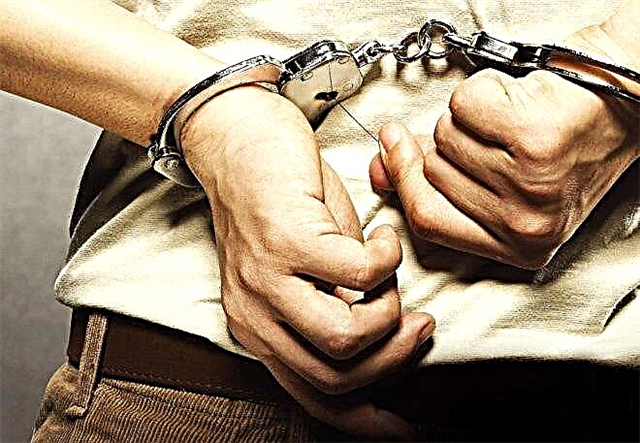For many years Germany was one of the safest countries in Europe. Visitors never ceased to admire the measured rhythm of life of the Germans, who felt absolutely no danger on the streets. But now everything has changed: since 2021, the Germans have noted a significant deterioration in the crime situation in the country. Many attribute this to the influx of refugees. However, according to official statistics, crime in Germany fell in general in 2021. But is it? Let's figure it out in order.

The most common crimes
As a country of many millions, Germany shows significant differences in the nature of crimes committed on its territory. Unfortunately, at the moment statistics are only available for 2021, but they clearly demonstrate the structure of crimes. So, among the most common criminal offenses are:
- violent crimes - 573 thousand cases were registered, 140 thousand of which were dangerous and serious bodily injuries;
- property crimes - a total of 2.37 million cases were recorded, making theft and robbery one of the most serious problems;
- crimes of a sexual nature - 47 thousand incidents were registered, however, the figures, due to the large number of unregistered cases, may be biased;
- murders - they are rare in Germany: only 761 cases were recorded in 2021, while only 373 people became victims (completed murder);
- politically motivated crimes - 23 thousand cases, most of which are the use of prohibited symbols.
Theft in Germany
Property offenses, in particular theft and robbery, accounted for 37% of the total number of offenses committed in 2021, making these crimes the biggest problem for Germans. The most common cases of theft are:
- shoplifting - 378 thousand cases were recorded;
- theft of bicycles - 332 thousand cases;
- theft of vehicles - 313 thousand cases, among which cars appeared in 36 thousand cases;
- burglaries and burglaries - 151 thousand cases;
- robberies and robberies - 43 thousand cases, among which only 2.5 thousand are pickpockets and robberies at gas stations.
These indicators have shown steady growth since 2021. Theft is not a crime of negligence, so the rise in these rates is alarming for the Germans.
Today, the central media publish tips on how to avoid becoming a victim of robbers, loudspeakers on trains warn passengers about pickpockets in the carriages, and on television they talk about new schemes of street fraudsters and new types of robbery. All this is a wonder for the Germans, but people from the post-Soviet countries are not particularly surprised.
Street thefts and robberies have become a serious problem in German society. Most often, criminals operate at public events, at sales in supermarkets and shops, in public transport.
Their losses exceed 50 million euros annually. At the same time, the detection rate leaves much to be desired: depending on the form of theft, it is 6-25%.
Firstly, this is due to the careless behavior of the Germans themselves, and secondly, to the ingenuity and cunning of criminals operating on the territory of several countries at once.

While working to prevent crime in Germany, the police never stop notifying the townsfolk and telling them about the methods of protection against theft and robbery, precautions and protection against pickpockets, the methods of "work" of burglars, car robbers, hijackers of two-wheeled vehicles and other criminals whose victims are at risk of becoming the Germans.
For example, the most common tricks used by street robbers are:
- "Antanztrick" (Antanztrick) - a form of street theft at public events, during which the victim is distracted by jumping movements and friendly physical contact of the robber (for example, hugs), in which the theft occurs.
- Der Rempel-Trick - a man in a crowd is chased by several criminals. At one point, one of them stumbles or crouches, thereby stopping the victim. In the confusion, the victim loses his wallet or mobile phone.
- Der Stadtplan-Trick - a stranger approaches the victim with a city map and asks for a specific direction or location. While the victim is distracted, she can lose the contents of the bag and pockets, and even the bag itself.
- "Trick of beggars" (Der Bettel-Trick) - an unaccompanied crowd of children surrounds the victim and begins to beg. While the confused person is trying to "fight off" the beggars, one of the children seizes the moment and steals the wallet.
- "Polluter Trick" (Beschmutzer-Trick) - after a victim visits an ATM, a supposedly random passer-by allegedly accidentally smears the victim with ketchup from a hot dog, pours lemonade or other dirty liquid on the victim. While the victim is assisted in getting rid of the stains, the money withdrawn from the ATM disappears.
From all this, the first intermediate conclusion can be drawn: the inventiveness of the robbers knows no boundaries, while any of their actions are primarily aimed at distracting the victim's attention, so do not let your vigilance be lulled - be always on the alert. Moreover, German cities are now far from as safe as they used to be.
The most dangerous cities in Germany
Statistical calculations make the small town of Trier, located near the border with Luxembourg, the most dangerous settlement in Germany. It is here that the highest number of crimes per 100 thousand inhabitants is observed. Similar indicators are shown by such "criminal areas" as Berchtesgaden and Rosenheim - here the authorities record more than 100 thousand crimes per 100 thousand inhabitants.
Objectively, this level of crime is due to the illegal entry and stay of foreign citizens on the territory of Germany. In Trier, for example, there is a reception center for refugees, while Rosenheim and Berchtesgaden lie on the so-called Balkan route, which is actively used by refugees.
If you do not take into account violations of migration legislation, then these areas will not even be included in the top 30 most dangerous settlements, and Berlin will be the most criminogenic.
Berlin
The capital of Germany is indeed its most dangerous city. The most common crimes in Berlin are street robberies, theft of handbags and hand luggage, pickpocketing and road thefts, damage to and theft of goods from shop windows. Prostitution, gambling and drug dealing are not uncommon here.
According to local statisticians, about 15 thousand people are registered in Berlin every year (14.5 thousand in 2021), which makes it a real “capital of crime”, as this city has been called in the press for several years. In general, only officially in 2021, more than half a million crimes were recorded in the capital.

This is due to a dozen and a half criminal clans operating in the capital. Over the past 20 years, organized crime has stretched out its tentacles like a giant octopus throughout the city. Police officers are working hard to keep Berlin safe by increasing street patrols and expanding a network of video cameras to monitor public order, but their resources are limited. And although the statistics show a positive trend and an improvement in the crime situation, citizens do not feel safe.
In 2021, the so-called kriminalitätsbelasteter оrte was even published - a previously classified list of the most dangerous places from the Berlin police, according to which the most dangerous areas of Berlin are:
- Alexanderplatz;
- Leopoldplatz;
- Kleiner Tiergarten;
- Schöneberg-Nord, Nollendorfplatz, "Regenbogen-Kiez" (Schöneberg-Nord, Nollendorfplatz, "Regenbogen-Kiez");
- Görlitzer Park;
- Warsaw Bridge (Warschauer Brücke);
- Kottbusser Tor;
- Hermannstrasse, Hermannplatz, Riga street (Hermannstraße, Hermannplatz, Rigaer Straße).
Compared to previous years, the number of dangerous places has been significantly reduced, since earlier kriminalitätsbelasteter оrte included about 20 locations. And yet, with the onset of darkness in these areas, local residents try not to appear.
Other "dangerous" cities
The capital, by the way, is not the only crime center in Germany. In addition to Berlin, the top ten dangerous also includes:
- Frankfurt am Main. In the Hessian metropolis last year, they counted about 14.9 thousand people, which is even more than in the capital. Crime is thriving here due to the fact that the city is a major tourist and business center.
- Hanover. Although the crime rate in Hanover is equal to that in the capital, the number of crimes committed here is several times less - in 2021, only 114 thousand cases. Looting, violent crime and theft prevail in Hanover.
- Dresden. With its 14.3 thousand people, Dresden became one of the national anti-leaders. Most often, violent crimes and thefts, as well as crimes related to drug trafficking, are committed in the city.
- Leipzig. There are 13.9 thousand crimes per 100 thousand people in Leipzig. The number of registered crimes is quite high - about 106 thousand were registered. However, despite the fact that the overall crime rate is decreasing, the number of sexual crimes, including rape, is growing.
- Galle. 12.7 thousand crimes committed per 100 thousand of the population is a huge indicator for a city with a population of 240 thousand. The most common crimes include domestic violence, bicycle theft and home theft.
Where is the safest place in Germany? Munich received this status in 2021. Last year, the crime rate in the city was only 6.6 thousand people, which is 1.5 times less than in the same Dresden or Hanover.
Moreover, the number of crimes in the Bavarian capital fell by 15.4% over the past year, which is one of the most significant achievements on a national scale.
Crime statistics: numbers and public sentiment
Police data sharply discord with public attitudes. According to police statistics, the number of crimes committed in Germany in 2021 began to decline sharply. In total, the police recorded 5.76 million incidents against 6.37 million crimes committed in 2021.
It's not just a 9.6 percent annualized decline, statisticians say - it's the largest drop in crime in 25 years and the lowest reported crime since the fall of the Berlin Wall. Such indicators were last observed back in 1992. The diagram will help you to visually familiarize yourself with them.
Against the background of a decline in federal indicators, crime rates in the regions are also falling. For example, the crime rate in Berlin in 2021 fell by 9%, and the number of reported pickpockets fell by 39.6%. However, despite such an unprecedented decline, experts advise against drawing premature conclusions about improving security in the country.
This position is also supported in society. Most Germans are convinced that life in Germany is becoming more and more dangerous every year. They are skeptical about the above statistics: a significant part of the population, judging by the discussions on social networks, considers the published data to be untrue and sees them as a "conspiracy theory", while others believe that statistics record only the results of the work of law enforcement agencies and do not reflects the real state of affairs with crime.
Many Germans associate the deterioration of the crime situation with the large number of migrants and refugees who have flooded the country. But is it?
Crime in Germany and migrants
From 2021 to 2021, the crime rate in Germany has shown continuous growth. It was during these years that the "invasion" of migrants took place. It is not surprising that an ordinary burgher, comparing these two facts, came to the conclusion that refugees from Africa and the Middle East are to blame for everything.
Plus New Year's events in Cologne, after which it is no longer customary to be delicate with migrants. Indeed, migrants are disproportionately represented in crime statistics today.

For example, in Lower Saxony, migrants account for about 15% of all crimes committed, which is incomparable with their share in the region's population. In other federal states, the share of crimes committed by migrants in the overall structure ranges from 8 to 12%.
Official statistics for the country: in 2021, foreigners committed 270 thousand criminal offenses, in 2021 - 293 thousand, in 2021 - about 265 thousand.And this despite the fact that in 2021 the total number of registered immigrants was about 1.5 million people ...
About a third of all crimes they commit are thefts, mostly street thefts. Another 24% are violent crimes and robberies. All this suggests that migrants have "increased criminal energy", and a stream of hooligans and rapists poured into Germany under the guise of refugees. In many ways, this is true, but there are exceptions.
Thus, the overwhelming majority of refugees arrived in the country from Iraq, Syria and Afghanistan - about 54% of the total number of newcomers. However, their share in thefts and robberies is only 16%.
The share of North Africans (immigrants from Gambia, Somalia, Nigeria, Morocco), in turn, is about 31%, although their share in the total structure of migrants is only 0.9%. All this suggests that people from countries where there is a military conflict behave much more modestly in Germany. But young North Africans, on the contrary, are not averse to spoiling the Germans' criminal statistics.
Some even find an explanation for this behavior. Due to the absence in the country of the outcome of the military conflict, they initially understand that they cannot stay in Germany forever, so the punishment for theft does not scare them - they simply have nothing to lose. However, the disproportionate number of crimes committed by them forms a certain stereotype and forces the country's leadership to take action.
Types of punishment in Germany
German criminal law is significantly different from the legislation of any country in the post-Soviet space. The German Penal Code (Strafgesetzbuch, StGB) defines a multilevel system of consequences for committing a criminal act. So, the system of sanctions in criminal legislation includes:
- Basic punishments. The main punishment can be in the form of a fine or imprisonment, in particular, in the form of:
- life imprisonment (paragraph 1 §38 StGB). This is an exceptional measure of responsibility applied in cases of particularly serious crimes, for example, daring murder (clause 2 §212 StGB), robbery resulting in the death of the victim (§251 StGB), treason (clause 2 §94 StGB) and other similar crimes ;
- imprisonment for a specified period. According to §38 StGB, the term of imprisonment can range from 1 month to 15 years. Applies to a wide range of crimes such as money forgery (§146 StGB), rape (§177 StGB), dangerous bodily harm (§224 StGB) or gross robbery (§250 StGB);
- fine. According to §40 StGB, the fine is imposed in daily rates - from 5 to 360 times the rate for a specific crime. The size of the rate is determined by the court in each case individually, depending on the personal and economic circumstances of the offender. As a rule, it is set at the amount of daily income that a criminal can receive in 1 day. The limits of such income are from 1 to 30 thousand €.If the offender cannot pay the fine, it is replaced by imprisonment in the equivalent of 1 daily rate = 1 day of imprisonment, according to §43 StGB. Such penalties may apply to minor offenses such as resistance to the police (§113 StGB § 1), minor bodily harm (§223 StGB) or petty theft (§ 242 StGB).
- Additional penalties. In accordance with §44 StGB, there is only one additional penalty in Germany - a ban on driving a vehicle. It can be established for a period of 1-3 years as an additional form of liability to imprisonment or a fine, and only when the crime was committed using or while using a car or other vehicle.
- Additional consequences. According to §45 StGB, they include a ban on holding public office, a ban on participation in public elections, a ban on active or passive participation in elections. The duration of such a ban and the rules for its application depend on the previously received punishment.
Any of these measures of responsibility can be imposed only by a competent court and only by its sentence. The execution of sentences in Germany is the responsibility of the Ministry of Justice, and the prosecutor is the direct executor, according to §451 StPO (CPC).
Conclusion
Summarizing all that has been said, we can conclude that Germany is no longer such a safe country as it was considered earlier. As statistics show, there have been no fundamental shifts in the level of crime, but the very structure of crime has changed. The Germans often associate this with the influx of migrants, although not all of them are associated with criminal activity.
Theft is the most common crime in Germany, and Berlin is considered the most dangerous city. Regardless, crime statistics for 2021 show encouraging shifts that may soon be noticed by German society as well.











